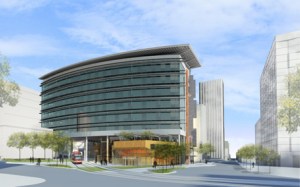Cascadia Center in Seattle
Your office building doesn’t have solar panels lining the roof, composting in the basement, or mechanically controlled venetian blinds on the outside of the building to direct sun in or out depending on the time of day? It doesn’t even generate and recycle all—yes, all—water used on site? Then your building isn’t living.
In the sustainability game, two proposed multi-story “living buildings” take sustainability to the urban environments of Portland and Seattle. And they outdo one another in the process with their triple net-zero—energy, water and waste—goals.
(LIST: Top 10 green buildings)

Oregon Sustainability Center in Portland
Both centers recently released their final designs as they prepare for construction in 2011. In Seattle, the Bullitt Foundation funds the Cascadia Center for Sustainable Design and Construction, a six-story (plus a basement) complex in the heart of the city. Portland’s Oregon Sustainability Center, a seven-story, $64 million project funded by the City of Portland, the Portland Development Commission and the Oregon University System will highlight the edge of Portland State University’s downtown campus’ “ecodistrict.”
Dennis Wilde, project manager at Portland’s Gerding Edlen developers, says the seven stories of his Oregon center and also the Seattle project further “puts the stake in the ground” signifying the Pacific Northwest as the leader in environmentally and socially responsible projects.
Both structures aim for Living Building Challenge certification from the Living Future Institute, a designation that makes LEED Platinum look downright simple. The buildings—really the largest sustainable living buildings ever proposed for North America—will serve to educate too, as data will be culled from the sites and used to push sustainable design.
These buildings aren’t just pretty architecture with innovative technology. They have to bring in rent checks—from sustainably minded tenants, of course—to help cover the 10% to 30% construction premium of building living.
(VIDEO: The Future of Green Cities in a Swedish Eco-Town)
Brian Court, lead architect on the Seattle project with The Miller Hull Partnership, says building an ultra-sustainable facility in one story is simple. Going six stories tall? That gets a bit tricky. With the main goal of not eating up valuable resources—energy consumption, water consumption, waste output and using non-toxic and renewable building materials—nibbling back a building’s hunger for resources turns paramount. But powering a six- or seven-story building with only one roof of solar panels forces architects to “whittle down the energy loads on the building even further,” Court says. Cascadia will go 100% solar, while the Oregon version plans solar, 200-foot-deep on-site wells that draw geothermal heat and bifacial panels that let visible light pass through while also generating electricity.
But energy signifies just one leg of the triple net-zero goal. With waste handled onsite relatively easily, the water factor—and there’s no shortage of that in the Pacific Northwest—provides challenges, especially in the tight footprints of a fully urban environment. All water must be generated onsite and disposed of onsite. Rainwater gets collected in cisterns at both sites and treated for consumption. Treated greywater—wastewater from such things as hand washing—gets recycled in toilets and to cool mechanical equipment. Blackwater—think toilet waste—visits onsite natural biological wastewater systems and then returns to the greywater system. Excess water and storm runoff stay out of the city sewer system by being treated and filtered into the ground.
With the two completely autonomous projects happening concurrently, there’s a bit of friendly competition that includes information sharing and giving each other a push in their quests as the “largest urban building to attempt the Living Building Challenge,” Wilde says.
And as the design practices gain popularity, maybe a blackwater system won’t be that foreign in your average office building. It certainly won’t be odd in the Pacific Northwest.
(MORE: Green living in cargo containers)






